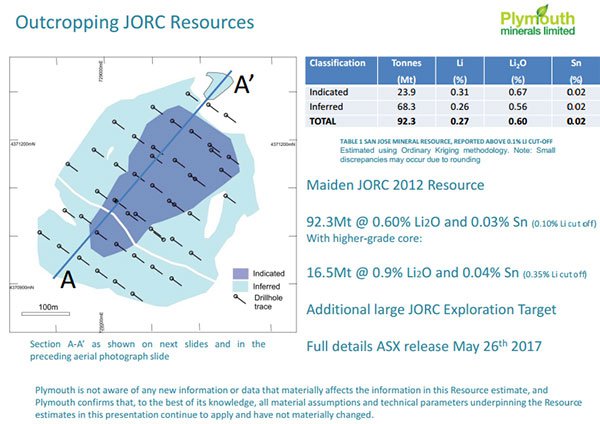Plymouth Minerals to maintain lithium recoveries
Published 05-JUL-2017 13:41 P.M.
|
2 minute read
Hey! Looks like you have stumbled on the section of our website where we have archived articles from our old business model.
In 2019 the original founding team returned to run Next Investors, we changed our business model to only write about stocks we carefully research and are invested in for the long term.
The below articles were written under our previous business model. We have kept these articles online here for your reference.
Our new mission is to build a high performing ASX micro cap investment portfolio and share our research, analysis and investment strategy with our readers.
Click Here to View Latest Articles
An update from Plymouth Minerals (ASX: PLH) regarding the San Jose lithium-tin project located in Spain has indicated that materials sourced from the deposit can be leached using both acid digest and sulphate calcine ‘front-end’ processing methods.
This is significant in terms of the company being able to achieve optimum recoveries while potentially lowering input costs.
Test work using conventional sulphate calcining/roasting techniques have achieved 95% lithium extraction from the host rock into the liquor. This was achieved at a 212 micron grinder size on non-beneficiating ore.
San Jose is a highly advanced lithium project, and a feasibility study completed in 1991 defined an open pit mining operation and a process flow sheet which produced lithium carbonate through acid leach or sulphate calcined processing, historical data that supports this latest development.

PLH’s Managing Director, Adrian Byass highlighted the fact that both are amenable to industry standard ‘back-end’ precipitation methods used to produce lithium carbonate, and both leach processes have historically been tested at San Jose with lithium carbonate having been produced in historic feasibility studies.
However, in the past, utilising a sulphuric acid flow sheet was considered the preferred method, due to readily available sulphuric acid in Western Spain. In parallel with the sulphuric acid process, PLH has been evaluating the sulphate calcined pathway to produce a final product of lithium carbonate, and management is buoyed by the latest results which included a maximum 97% lithium recovery.
Of course PLH does remain a speculative stock and investors should seek professional financial advice if considering this stock for their portfolio.
Results confirm historical work and point to potentially lower operating expenditure
Summing up the significance of this development, Byass said, “This result confirms historical work as we have two viable leach methods and industry standard precipitation, which is essentially the same as that employed by all hardrock and mineral producers”.
Byass said the company would now economically assess the impacts of process options and the potentially generous operating expenditure benefits enjoyed by sulphate calcining.
Ongoing process work will flow into the Mining Lease Application submission which outlines the mining, processing, economic modelling and marketing for a lithium-tin mine at San Jose.
This document has been prepared in collaboration with PLH’s local partner, Valoriza Mineria, a subsidiary of major listed Spanish construction company Sacyr.
PLH can earn up to 75% of San Jose by completing a feasibility study within four years, which should involve expenditure of approximately $6 million in staged increments.
General Information Only
S3 Consortium Pty Ltd (S3, ‘we’, ‘us’, ‘our’) (CAR No. 433913) is a corporate authorised representative of LeMessurier Securities Pty Ltd (AFSL No. 296877). The information contained in this article is general information and is for informational purposes only. Any advice is general advice only. Any advice contained in this article does not constitute personal advice and S3 has not taken into consideration your personal objectives, financial situation or needs. Please seek your own independent professional advice before making any financial investment decision. Those persons acting upon information contained in this article do so entirely at their own risk.
Conflicts of Interest Notice
S3 and its associated entities may hold investments in companies featured in its articles, including through being paid in the securities of the companies we provide commentary on. We disclose the securities held in relation to a particular company that we provide commentary on. Refer to our Disclosure Policy for information on our self-imposed trading blackouts, hold conditions and de-risking (sell conditions) which seek to mitigate against any potential conflicts of interest.
Publication Notice and Disclaimer
The information contained in this article is current as at the publication date. At the time of publishing, the information contained in this article is based on sources which are available in the public domain that we consider to be reliable, and our own analysis of those sources. The views of the author may not reflect the views of the AFSL holder. Any decision by you to purchase securities in the companies featured in this article should be done so after you have sought your own independent professional advice regarding this information and made your own inquiries as to the validity of any information in this article.
Any forward-looking statements contained in this article are not guarantees or predictions of future performance, and involve known and unknown risks, uncertainties and other factors, many of which are beyond our control, and which may cause actual results or performance of companies featured to differ materially from those expressed in the statements contained in this article. S3 cannot and does not give any assurance that the results or performance expressed or implied by any forward-looking statements contained in this article will actually occur and readers are cautioned not to put undue reliance on forward-looking statements.
This article may include references to our past investing performance. Past performance is not a reliable indicator of our future investing performance.



